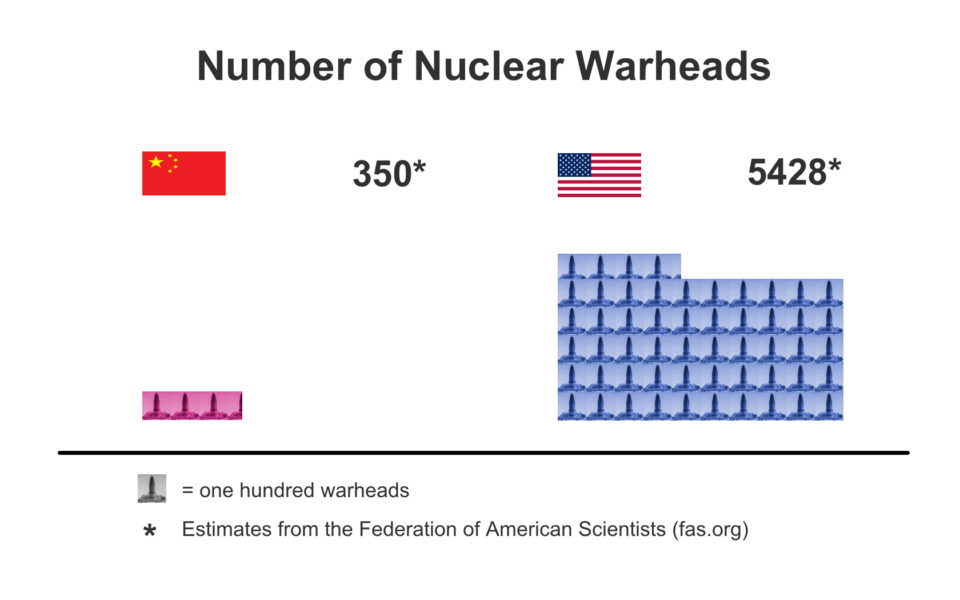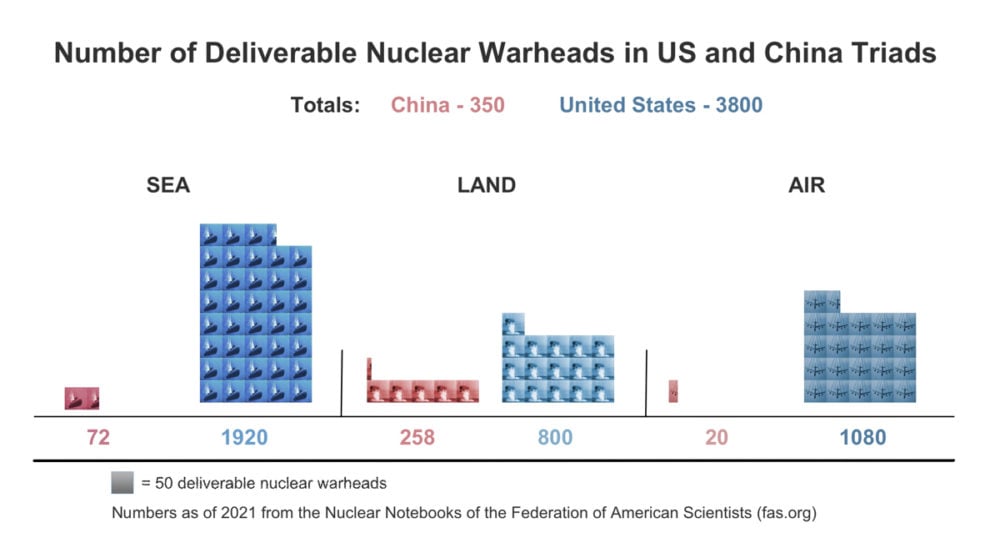The United States and China appear on the verge of starting a new nuclear arms race. Admiral Richard, the commander of the US Strategic Command, told Congress it is already well underway and that the United States risks falling behind.
Unfortunately, his assessment of the US-China nuclear balance and his proposals to improve it are based on questionable characterizations of China’s nuclear weapons program. If Congress accepts them, it is likely to respond in ways that will increase the danger Chinese nuclear weapons create for the United States.
Pots and kettles
The first is the commander’s assertion that Chinese declarations on when and why China might use or threaten to use nuclear weapons are “opaque.” It’s an odd statement when you consider that US leaders seem far less willing to delimit US nuclear use options.
On the day of its first nuclear test in 1964 the government of the People’s Republic of China (PRC) committed to “never at any time and under any circumstance be the first to use nuclear weapons.” It continues to repeat that commitment in official statements on Chinese nuclear weapons policy. The United States government, on the other hand, is unwilling to say whether it will use nuclear weapons first in a conflict and prefers to keep adversaries guessing.
Moreover, authoritative Chinese military texts explicitly state Chinese nuclear weapons will only be used to retaliate after China has been attacked with nuclear weapons. They are very clear that Chinese nuclear weapons “will not be used to deter non-nuclear enemy military activity.” Compare that with Richard’s February 2021 testimony to the Senate Armed Service Committee, when he said the United States may use nuclear weapons to deter “a strategic non-nuclear attack against our vital interests.”
Which government’s nuclear weapons use policy is more opaque?
The problem is not that Chinese nuclear policy is unclear, it’s that US officials don’t believe it. Last February Richard told the Senate he “could drive a truck” through supposed holes in China’s no first use policy. US officials are entitled to their doubts about Chinese veracity. But it is misleading to claim, as Richard did in his recent testimony to House appropriators, that Chinese nuclear policy is purposefully vague, or that US declaratory policy is more transparent.
Strategic hyperbolics
Another questionable assertion in Richard’s recent testimony is that “The strategic security environment is now a three-party nuclear-peer reality.” The three nuclear peers he identifies are the United States, Russia, and China. But an apples-to-apples comparison does not justify describing China as a nuclear peer of the United States.
The largest and most obvious difference is in the number of US and Chinese nuclear warheads.

China could double the size of its nuclear stockpile, as Richard claims it will, and the United States would still retain a more than 7 to 1 advantage. But there is also a huge and important disparity in US and Chinese means to deliver those warheads, which compounds the hyperbole in Richard’s testimony to Congress.

Richard’s congressional testimony suggests that because China can deliver nuclear warheads by sea, land, and air; because it also has what is called a “nuclear triad,” this creates a form of strategic equality with the United States. But the air and sea legs of the Chinese triad are miniscule by comparison.
One US Ohio-class ballistic missile submarine carries 24 missiles, and each missile can carry up to eight nuclear warheads. Two of those submarines can deliver more nuclear warheads to targets in China than all three legs of the Chinese nuclear triad can deliver. The United States has 14 of them. US aircraft can deliver up to 54 times more nuclear warheads than Chinese aircraft.
Richard may think stored US warheads don’t count. But China keeps nearly all its nuclear warheads in storage, so a tally excluding stored warheads would put the total Chinese number at close to zero. Richard may also be factoring US limitations under the New START agreement into his comparison of US and Chinese capabilities. But his assessment, and his request for more funding, are both based on future expectations. They are also based on warheads and delivery vehicles China has not, and still may not, build. Moreover, Chinese future expectations may presume the New START agreement, which expires in 2026, is unlikely to be extended.
No matter how you slice the numbers, China is not a “nuclear peer” of the United States and is not on its way to becoming one in the foreseeable future.
Unsubstantiated speculation
The most troubling claim in Richard’s recent testimony is that China “will increase the role of nuclear weapons in its defense strategies.” Unfortunately, he offered no supporting evidence in his public statement, other than to say China now has a “survivable nuclear triad.”
It is hard to imagine how a person with Admiral Richard’s background could believe the tiny air and sea legs of China’s triad are that robust. The six submarines that carry China’s 72 submarine-launched nuclear missiles are noisy and easy to track, which may be why they do not go on routine armed patrols. And it is highly unlikely China’s 20 air-launched nuclear weapons or the planes that deliver them could survive an earnest US attempt to preemptively destroy them.
Richard offered a few more details in a 2020 discussion with reporters. He said updates to Chinese delivery systems are what “you have to look at” to see if China will use nuclear weapons for purposes other than retaliation. He said the JL-3 was a “great example”. It is a submarine-launched missile, still under development, that can fly 2,000 km farther than the JL-2 missile China fielded in 2015.
The admiral believes the development of the JL-3 is a “watershed moment” because it allows China “to directly threaten our homeland from a ballistic missile submarine.” But so could the JL-2 from a patrol in the Pacific west of Hawaii. Perhaps Richard was considering that Chinese subs are easy to find in the open ocean, and that’s why he sees being able to launch from the shallower and congested seas closer to China shores, where a noisy submarine might hide or be protected, as a game-changing development.
Even if you believe the JL-3 provides a new Chinese capability, how does having a longer range indicate China would launch the new missile for purposes other than retaliation? And how does it prove, as Richard argues, that the United States has “no margin left” in a new nuclear arms race with China that compels Congress to “recapitalize our strategic triad?”
Final thoughts
Nuclear war planning may create an understandable but debilitating suspicion that impairs the judgment of people who take on this psychologically taxing responsibility.
In the very early days of the Cold War, when the United States had a 17 to 1 advantage in nuclear numbers over the Soviet Union, US Secretary of Defense Robert McNamara argued the US could lock in that advantage through nuclear arms control agreements, beginning with limitations on testing. Every member of the Joint Chiefs of Staff opposed a test ban. They argued the Soviets would cheat by testing their weapons on the far side of the moon. McNamara told them “you’re out of your mind, that’s absurd.”
Admiral Richard’s sensational mischaracterization of the US-China nuclear balance may be a product of the same tortured thinking. The next best explanation is that he’s intentionally exploiting US concerns about China to goad Congress into spending more money on new nuclear weapons.
If we learned anything from the Cold War, it’s that no one ever wins a nuclear arms race. Congress should keep that in mind before it decides to finance another one. The only rational approach to the problem of nuclear war is dialog and negotiation between nuclear-armed adversaries, no matter how difficult or unpalatable that may be.

